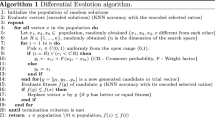Abstract
Financial ratios are commonly employed to measure a corporate financial performance. In recent years a considerable amount of research has been directed towards the analysis of the predictive power of financial ratios as influential factors of corporate stock market behavior. In this paper we propose a constraint-based evolutionary classification tree (CECT) approach that combines both the constraint-based reasoning and evolutionary techniques to generate useful patterns from data in a more effective way. The proposed approach is experimented, tested and compared with a regular genetic algorithm (GA) to predict corporate financial performance using data from Taiwan Economy Journal (TEJ). Better prediction effectiveness of CECT approach is obtained than those of regular GA and C5.0.
Preview
Unable to display preview. Download preview PDF.
Similar content being viewed by others
References
Abdullah, M.K.: CAN: Chain of Nodes Approach to Direct Rule Induction. IEEE Transactions on Systems, Man, and Cybernetics, Part B: Cybernetics 29(6), 758–770 (1999)
Breiman, L., Friedman, J.H., Olshen, R.A., Stone, C.J.: Classification and Regression Trees. Wadsworth, Los Angeles (1984)
Chiu, C., Hsu, P.L.: A Constraint-Based Genetic Algorithm Approach for Mining Classification Rules. IEEE Transactions on Systems, Man, and Cybernetics (forthcoming)
Ciccolo, J., Fromm, G.: ‘Q’ and the Theory of Investment. Journal of Finance 34(2), 535–547 (1979)
Coats, P.K., Fant, L.F.: A Neural Network Approach to Forecasting Financial Distress. The Journal of Business Forecasting, 9–12 (1991) (winter 1991-1992)
De Jong, K.A., Spears, W.M., Gordon, D.F.: Using Genetic Algorithms for Concept Learning. Machine Learning 13, 161–188 (1993)
Ganesalingam, S.: Detection of Financial Distress via Multivariate Statistical Analysis. Managerial Finance 27(4), 45–55 (2001)
Greene, D.P., Smith, S.F.: Competition-Based Induction of Decision Models from Examples. Machine Learning 13, 229–257 (1993)
Hartmann, C.R.P., Varshney, P.K., Mehrotra, K.G., Gerberich, C.L.: Application of Information Theory to the Construction of Efficient Decision Trees. IEEE Trans. Inform. Theory IT-28, 565–577 (1982)
Janikow, C.Z.: A Knowledge-Intensive Genetic Algorithm for Supervised Learning. Machine Learning 13, 189–228 (1993)
Lindenberg, E.B., Ross, S.A.: Tobin’s q Ratio and Industrial Organization. Journal of Business 54, 1–32 (1981)
Nadel, B.: Tree Search and Arc Consistency in Constraint-Satisfaction Algorithms. In: Search in Artificial Intelligence, New York, pp. 287–342 (1988)
Noda, E., Freitas, A.A., Lopes, H.S.: Discovering Interesting Prediction Rules with a Genetic Algorithm. In: Proc. Congress on Evolutionary Computation, Washington D.C., July 1999, pp. 1322–1329 (1999)
Purdom, P.: Search Rearrangement Backtracking and Polynomial Average Time. Artificial Intelligence 21, 117–133 (1983)
Quinlan, J.R.: C4.5: Programs for Machine Learning. Morgan Kaufman Series. In: Machine Learning. Kluwer Academic Publishers, Dordrecht (1993)
Shah, J.R., Murataza, M.B.: A Neural Network Based Clustering Procedure for Bankruptcy Prediction. American Business Review, 80–86 (June 2000)
Tan, K.C., Lim, M.H., Yao, X., Wang, L.P.: Recent Advances in Simulated Evolution and Learning. World Scientific, Singapore (2004)
Author information
Authors and Affiliations
Editor information
Editors and Affiliations
Rights and permissions
Copyright information
© 2005 Springer-Verlag Berlin Heidelberg
About this paper
Cite this paper
Hsu, CI., Hsu, Y.L., Hsu, P.L. (2005). Financial Performance Prediction Using Constraint-Based Evolutionary Classification Tree (CECT) Approach. In: Wang, L., Chen, K., Ong, Y.S. (eds) Advances in Natural Computation. ICNC 2005. Lecture Notes in Computer Science, vol 3612. Springer, Berlin, Heidelberg. https://doi.org/10.1007/11539902_100
Download citation
DOI: https://doi.org/10.1007/11539902_100
Publisher Name: Springer, Berlin, Heidelberg
Print ISBN: 978-3-540-28320-1
Online ISBN: 978-3-540-31863-7
eBook Packages: Computer ScienceComputer Science (R0)




